What Is A Golden Financier?
A golden financier is a classic French almond cake characterized by its distinctive golden-brown exterior and rich buttery flavor. These petite rectangular treats derive their name from both their gold-like appearance and their popularity among the financial professionals of Paris in the late 19th century. Traditional financiers feature a perfect balance of nutty brown butter (beurre noisette) almond flour and whipped egg whites creating their signature crisp exterior and moist tender center.
The hallmark “golden” quality comes from two key elements: the amber-hued brown butter that infuses the batter with its nutty depth and the caramelization that occurs during baking which produces the beautiful golden crust. Unlike many other French pastries financiers maintain a rustic elegance with their simple rectangular shape inspired by gold bars from the nearby financial district.
Texturally a perfect golden financier offers a delightful contrast between its crisp caramelized exterior and moist almond-scented interior. The flavor profile combines rich butter notes with the subtle sweetness of almonds creating a sophisticated pastry that isn’t overly sweet. Many bakers enhance this base with additions like fresh berries citrus zest or even a touch of honey to complement the nutty undertones.
Preparing golden financiers requires attention to detail particularly when browning the butter to achieve that perfect nutty aroma without burning it. The traditional molds are small rectangular metal forms but modern bakers often use mini muffin tins or specialized financier molds for convenience. Regardless of the vessel used the secret to achieving that coveted golden exterior lies in properly preheating your oven and allowing the financiers to bake until they develop their characteristic golden crown.
Why You’ll Love This Golden Financier Recipe
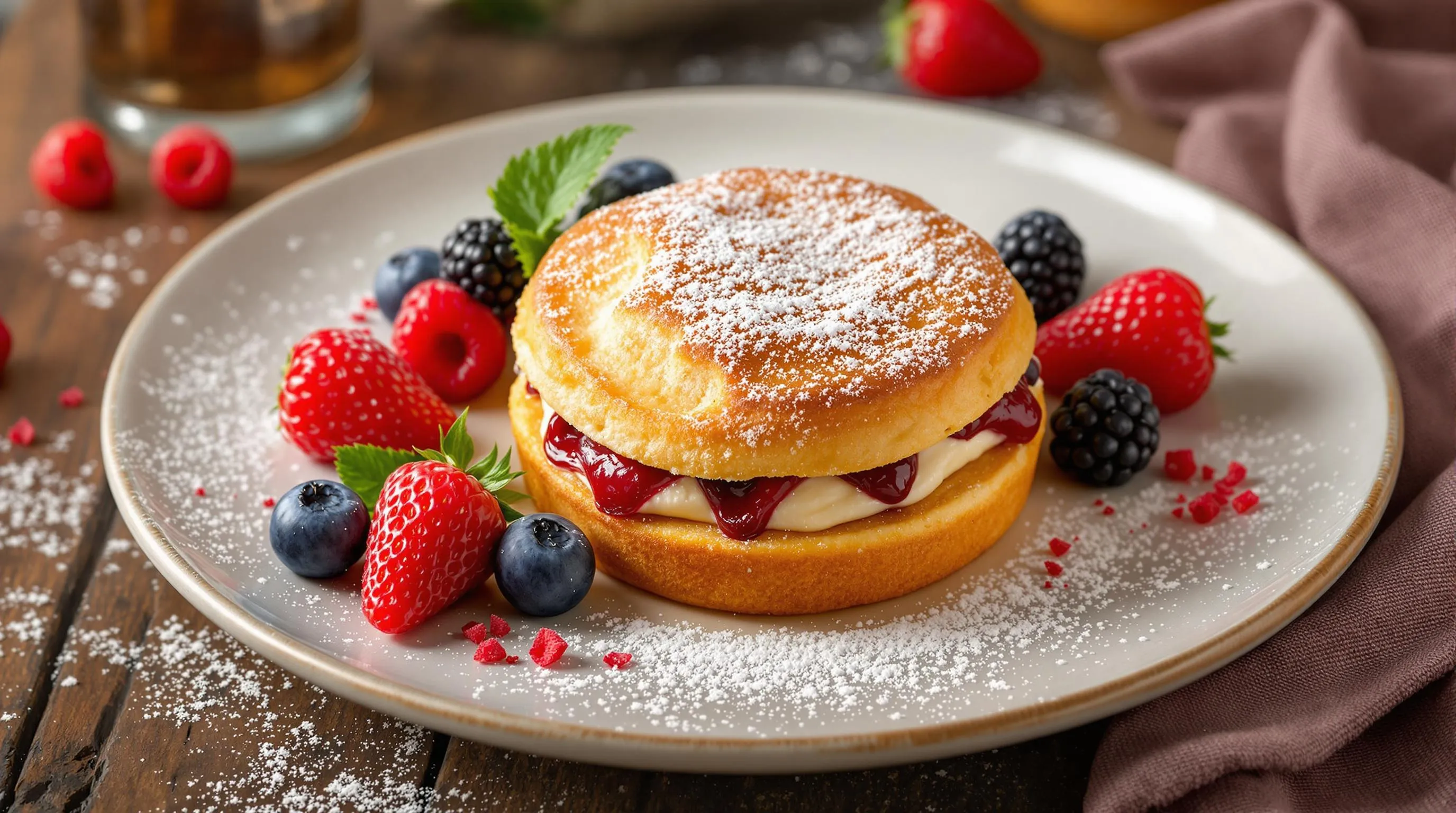
These elegant French treats will quickly become your new favorite dessert to prepare at home. The delicate almond flavor shines through in every bite thanks to the generous amount of almond flour that forms the foundation of these cakes.
You’ll appreciate the distinctive nutty aroma and depth of flavor that comes from the brown butter (beurre noisette). This special ingredient transforms ordinary butter into a caramelized masterpiece that elevates these small cakes far beyond basic pastries.
Simplicity is another hallmark of this recipe. With just a handful of basic ingredients—almond flour, egg whites, sugar, flour, vanilla, and butter—you can create something truly extraordinary without an extensive shopping list.
Time-conscious bakers will celebrate how quickly these come together. The entire preparation process takes only about 30 minutes from start to finish, with a short baking time of just 12-18 minutes. This makes them perfect for last-minute entertaining or satisfying sudden sweet cravings.
The versatility of financiers allows for creative expression. While traditionally baked in rectangular molds resembling gold bars (hence their name), you can easily use mini muffin tins or silicone molds for equally delicious results.
Each financier offers a textural delight with its crisp exterior giving way to a moist, tender crumb inside. This contrast makes them particularly satisfying alongside a cup of coffee or tea, creating a moment of simple luxury in your day.
Ingredients You’ll Need
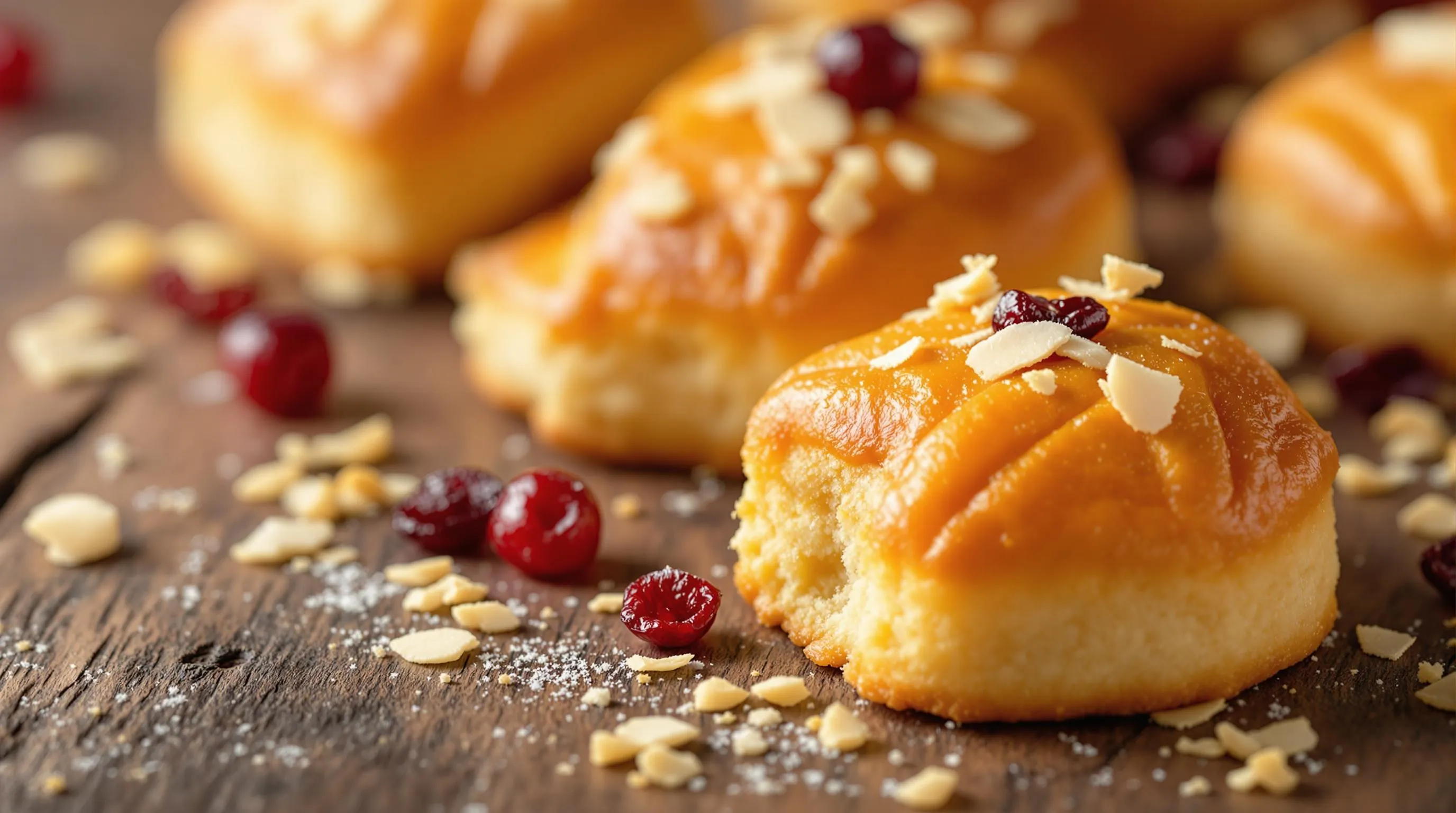
Creating perfect golden financiers requires quality ingredients that work together to achieve that signature nutty flavor and delicate texture. Let’s gather everything you’ll need for this classic French treat.
For The Batter
- 100-115g unsalted butter (for making beurre noisette)
- 85-100g almond flour, finely ground
- 30g all-purpose or pastry flour
- 125-150g icing sugar
- 3-4 large egg whites (approximately 95-140g)
- Pinch of salt
- 1 teaspoon vanilla extract or almond extract (optional)
The star ingredient here is undoubtedly the beurre noisette or brown butter. This transformed butter provides the distinctive nutty aroma and rich flavor that makes financiers so irresistible. Almond flour delivers that signature tender crumb while icing sugar ensures a delicate sweetness throughout. Egg whites act as the primary leavening agent creating that perfect balance between a crisp exterior and moist interior.
For The Garnish
- Dried cherries
- Almond flakes
- Fresh berries (optional)
- Powdered sugar for dusting (optional)
Traditional garnishes include dried cherries or almond flakes pressed gently into the batter before baking. These additions not only enhance the visual appeal but complement the nutty flavor profile perfectly. Many bakers press these garnishes into the top of each financier before baking to create an elegant presentation. You might consider dusting the finished financiers with a light coating of powdered sugar for an extra touch of sophistication.
Equipment Required
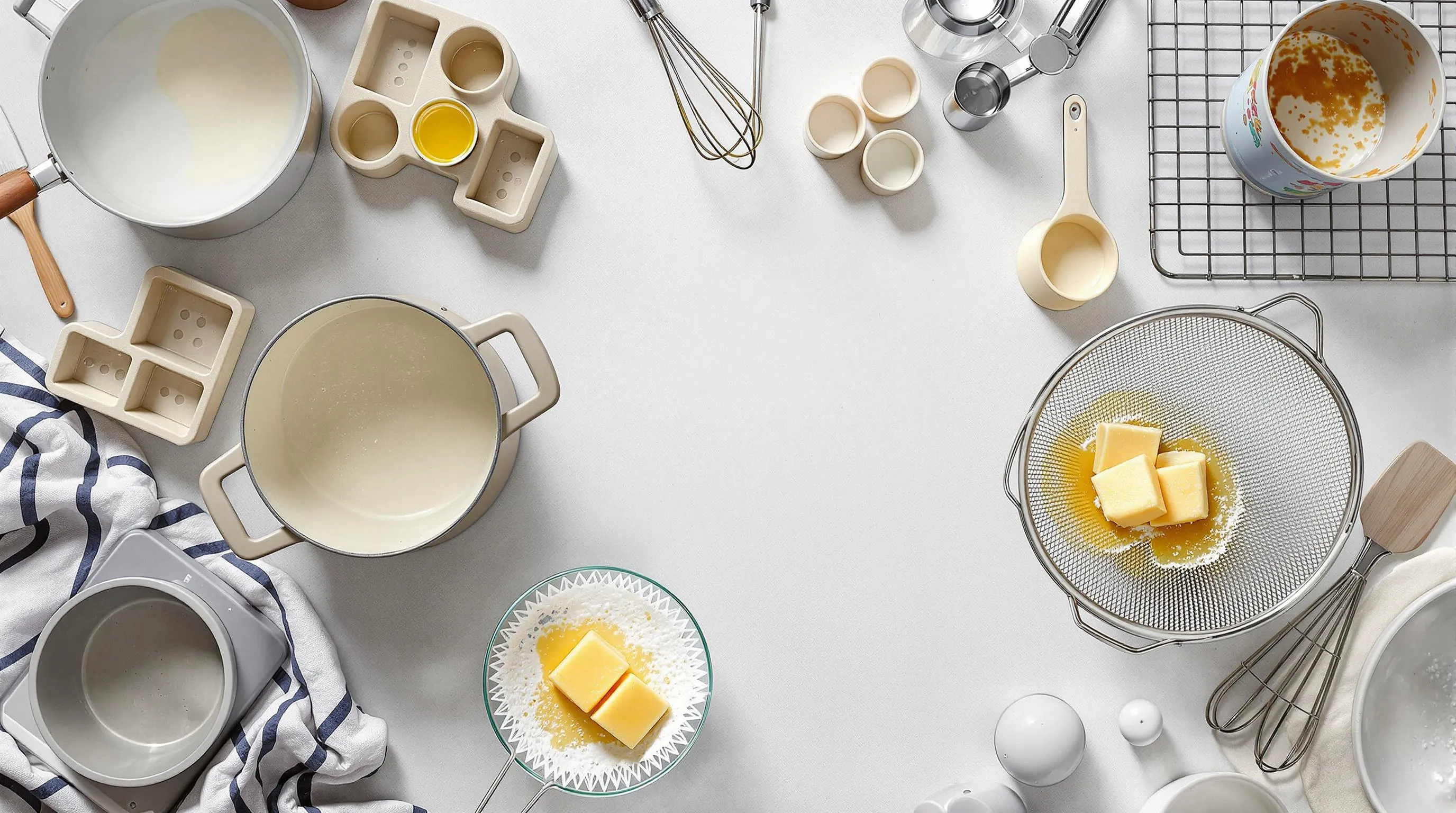
To create perfect golden financiers at home you’ll need a few exact tools that help achieve their distinctive texture and appearance. Traditional Parisian bakers use rectangular molds resembling gold bars which pay homage to the pastry’s origins in the financial district of Paris.
Essential baking equipment:
- Financier molds (traditional rectangular gold bar shapes) or mini muffin tins as an alternative
- Medium saucepan for browning butter
- Fine mesh strainer to filter the browned butter
- Mixing bowls (medium and large)
- Whisk for combining dry ingredients
- Rubber spatula for folding the mixture
- Kitchen scale for precise measurements
- Cooling rack for perfect texture development
- Pastry brush for applying butter to molds
- Measuring cups and spoons
The proper molds contribute significantly to achieving the authentic gold bar appearance of financiers. But standard mini muffin tins work effectively if specialized molds aren’t available. Your saucepan should have a light-colored interior which makes monitoring the butter’s color change easier during the browning process.
Quality baking equipment ensures even heat distribution which results in the characteristic golden crown and caramelized exterior while maintaining the moist interior that makes these French almond cakes so irresistible. Pay special attention to the fine mesh strainer as it removes any burned milk solids from your beurre noisette maintaining the nutty flavor without any bitter notes.
While not strictly necessary many professional bakers recommend using a kitchen scale for measuring ingredients by weight rather than volume for consistent results every time. This precision particularly matters when working with the delicate balance of almond flour and egg whites that creates the signature texture of financiers.
How To Make Golden Financiers
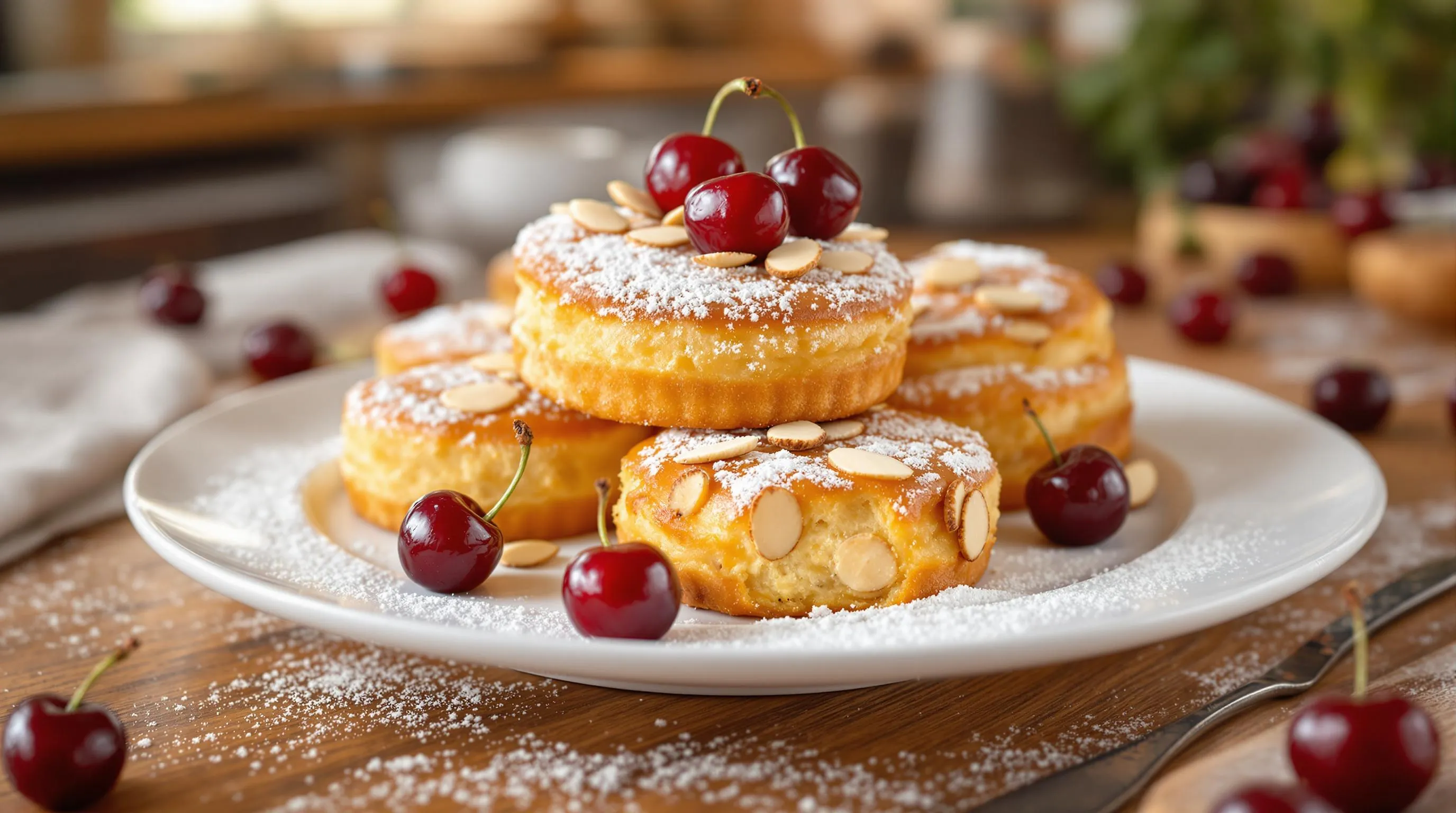
Creating these classic French almond cakes requires attention to detail and proper technique to achieve their signature golden color and rich buttery flavor. Follow these step-by-step instructions for bakery-worthy financiers.
Preparing The Brown Butter
Begin by melting unsalted butter in a small saucepan over medium heat. Watch carefully as the butter melts and the milk solids separate, continuing to cook until they turn a deep amber color. The butter will emit a distinctly nutty aroma when it reaches the perfect stage of browning—this is what the French call beurre noisette. Remove your pan from heat immediately to prevent burning. Strain the browned butter through a fine mesh sieve to remove any solids that could affect the texture of your financiers. Allow the brown butter to cool slightly while maintaining its liquid state before incorporating it into your batter.
Mixing The Dry Ingredients
Sift together your flour, icing sugar, and almond flour into a mixing bowl to ensure there are no lumps. This sifting step creates the fine texture that financiers are known for. Add a pinch of salt to enhance the flavors. Take your egg whites and whisk them directly into the dry ingredient mixture until completely combined. Unlike many baked goods, financiers don’t require the egg whites to be beaten separately—they should simply be incorporated to create a smooth base for your batter.
Combining The Wet Ingredients
Pour the cooled brown butter into your batter mixture in three separate additions. Whisk thoroughly between each addition to ensure proper emulsification and a silky consistency. Add a splash of vanilla extract or vanilla bean paste to enhance the rich flavor profile. The batter should appear glossy and have a pourable consistency when properly mixed. Cover your financier batter with plastic wrap and refrigerate for at least one hour—this resting period allows the flavors to develop and the batter to firm up slightly for better baking results.
Baking The Financiers
Preheat your oven to 350°F (180°C) and prepare your baking molds by greasing them thoroughly. Fill each cavity about three-quarters full with the chilled batter to allow room for rising. For a decorative touch, place a fresh cherry or sliced almond on top of each financier before baking. Slide your filled molds into the preheated oven and bake for 15-18 minutes until the edges turn golden brown and the tops develop their characteristic domed “crown.” Test for doneness by inserting a toothpick into the center—it should come out clean when the financiers are perfectly baked. Allow the financiers to cool briefly in their molds before transferring them to a wire rack. Dust with a light shower of powdered sugar just before serving to highlight their golden hue and add a touch of elegance to these buttery treats.
Tips For Perfect Golden Financiers
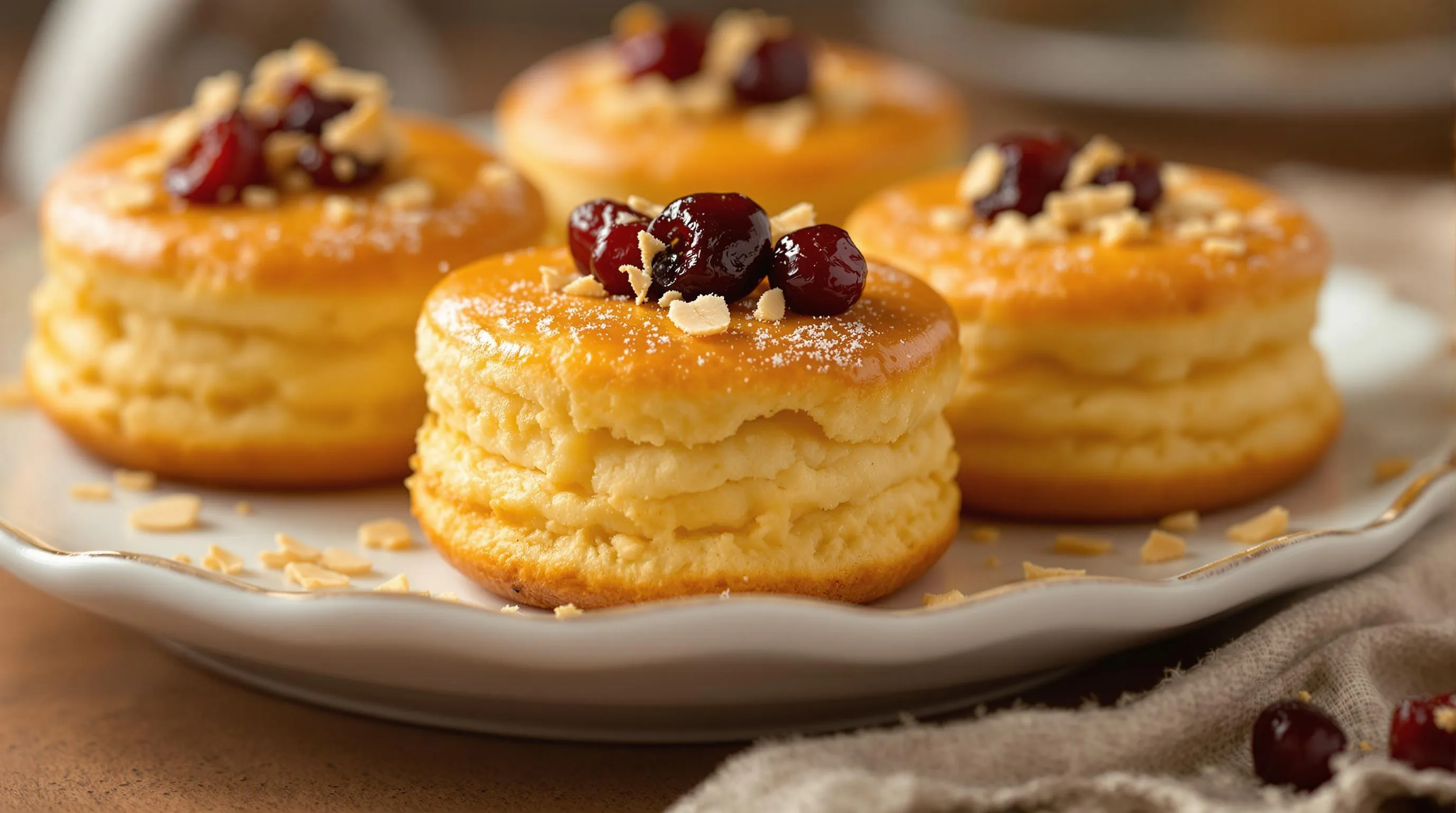
Achieving that signature golden crown and moist interior takes attention to detail and proper technique. Follow these expert tips to ensure your financiers turn out perfectly every time:
- Master the beurre noisette: Brown butter is the foundation of exceptional financiers. Heat unsalted butter in a saucepan until it transforms into a gorgeous amber color with a distinctly nutty aroma. This crucial step provides the characteristic golden hue and rich flavor that defines authentic financiers.
- Balance your ingredients carefully: Combine almond flour for moisture and nuttiness, egg whites for lightness, icing sugar for sweetness, and a small amount of pastry flour for structure. Adding a pinch of salt enhances all flavors, while vanilla or almond extract can intensify the aromatic profile.
- Follow the proper mixing sequence: Start by whisking together all dry ingredients thoroughly. Then incorporate egg whites smoothly before slowly streaming in the cooled brown butter. This methodical approach prevents curdling and ensures a silky batter consistency.
- Rest the batter: Allow your prepared batter to chill in the refrigerator for approximately one hour before baking. This resting period helps financiers maintain their shape and develop their distinctive texture during baking.
- Watch your oven temperature: Preheat your oven to 180-200°C (350-390°F) for optimal results. The proper temperature creates that coveted contrast between the crisp exterior and tender interior.
- Fill molds appropriately: Traditional rectangular molds produce the classic financier shape, but any small mold will work. Fill each cavity about three-quarters full to allow room for rising.
- Add a signature touch: Place a dried cherry or almond flake on top of each financier before baking for visual appeal and complementary flavor.
- Know when they’re done: Bake for 15-20 minutes or until the edges develop a deep golden brown color. The tops should spring back slightly when gently pressed.
- Cool strategically: Allow financiers to cool slightly in their molds before removing. This brief resting period helps them set properly and retain their structure.
- Serve at their best: Enjoy financiers fresh for the ultimate texture experience. They also freeze remarkably well and can be reheated with excellent results when you’re ready to serve them.
These delicate French cakes offer the perfect accompaniment to your afternoon tea or coffee, providing a moment of simple elegance with their rich nutty flavor and perfect textural contrast.
Variations To Try

While the classic golden financier is delightful on its own, several creative variations can transform this elegant French treat into something even more special. These adaptations maintain the rich buttery base while introducing new flavors and textures.
Chocolate Golden Financier
Transform your classic financiers into chocolate delights by incorporating cocoa powder into the batter. Add 2-3 tablespoons of high-quality cocoa powder to your dry ingredients before mixing with the egg whites. For an even more indulgent treat, fold in dark chocolate chips just before filling your molds. The richness of chocolate pairs beautifully with the nutty brown butter base, creating a sophisticated flavor profile that chocolate enthusiasts will adore.
You can also dip cooled financiers halfway into melted dark chocolate for a striking presentation. The contrast between the tender cake and the firm chocolate coating adds both visual appeal and textural interest. For special occasions, consider topping with a sprinkle of gold dust or flakes to honor the “financial” origins of this classic pastry.
Fruit-Topped Golden Financier
Fresh berries add brightness and acidity that balances the richness of financiers perfectly. Before baking, press raspberries, blackberries, or blueberries gently into the batter. The fruit creates pockets of juicy freshness that contrast wonderfully with the caramelized exterior of the cakes.
Stone fruits like plums, apricots, or cherries work beautifully too—simply slice them thinly and arrange decoratively on top of the batter before baking. During summer months, try placing a thin slice of peach or nectarine on each financier for a seasonal twist. The natural sugars in the fruit caramelize slightly during baking, improving the golden quality of these treats.
For a citrus variation, add orange or clementine zest to your batter and top with a thin slice of candied citrus. This bright modification cuts through the richness of the brown butter while complementing the almond notes in the cake.
You might also experiment with coconut flour in place of some of the almond flour, creating a tropical variation that pairs exceptionally well with slices of mango or passion fruit. The possibilities are nearly endless, allowing you to adapt these versatile treats to any season or occasion.
Storage And Make-Ahead Instructions

Proper storage is essential to maintain the delicate texture and rich flavor of your golden financiers. These buttery French treats can be enjoyed fresh from the oven or prepared ahead of time for convenience.
Storing at Room Temperature
Golden financiers maintain their quality when stored in an airtight container at room temperature. They remain fresh for up to 3 days when properly covered, preserving their distinctive nutty aroma and moist interior. Arrange them in a single layer to prevent sticking and maintain their elegant shape.
Refrigeration
For longer storage periods, refrigeration is recommended. Place your financiers in a sealed container and store in the refrigerator for up to one week. Remember to bring them back to room temperature before serving to restore their softness and full flavor profile. This typically takes about 30 minutes on your counter.
Freezing Options
These delicate almond cakes freeze exceptionally well, making them perfect for advance preparation. To freeze, place cooled financiers in a freezer-safe container, separating layers with parchment paper to prevent sticking. They can be stored frozen for up to 3 months without compromising quality.
When ready to enjoy, defrost your frozen financiers overnight in the refrigerator for a gradual thaw. Alternatively, let them sit at room temperature for about an hour before serving. This patience will be rewarded with financiers that taste nearly as fresh as the day they were baked.
Serving Recommendations
Golden financiers truly shine when served slightly warm, as heat enhances their nutty aroma and creates the perfect contrast between the crisp exterior and tender interior. To reheat, place them in a 300°F (150°C) oven for 5 minutes. This brief warming revitalizes their texture and intensifies the brown butter flavor notes.
Make-Ahead Tips
The financier batter benefits from resting time, making this recipe ideal for advance preparation. You can refrigerate the prepared batter in an airtight container for up to 2 days before baking. This rest period actually enhances the flavor development and creates an even more golden exterior when baked.
Fill your molds just before baking for optimal results, as the batter will spread more evenly when at room temperature. This make-ahead flexibility allows you to enjoy freshly baked financiers whenever desired, with minimal day-of effort.
Serving Suggestions
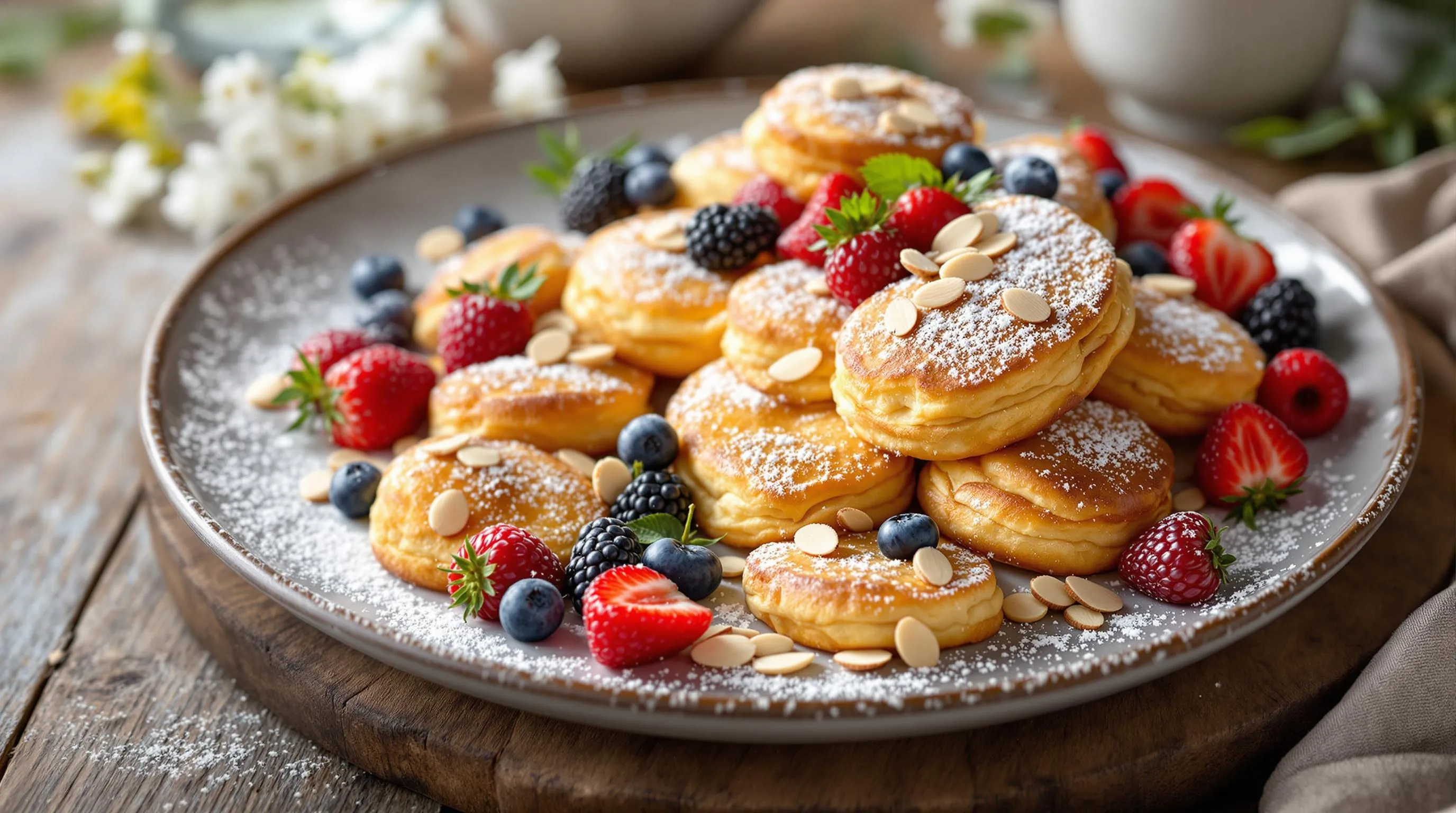
Golden financiers shine brightest when presented with thoughtful accompaniments that enhance their buttery almond flavor. These elegant French cakes offer versatility that lets you create memorable dessert experiences with minimal effort.
Serve your financiers plain with a light dusting of powdered sugar to highlight their naturally rich flavor profile. This classic presentation allows the nutty notes from the beurre noisette and almond flour to take center stage. A simple sprinkle of confectioners’ sugar adds visual appeal and a touch of additional sweetness without overwhelming the delicate taste.
Fresh berries make excellent companions to golden financiers. Try pairing these buttery treats with raspberries strawberries or blueberries for a burst of bright flavor that balances the richness. The slight acidity of fresh fruit cuts through the butter creating a harmonious taste experience.
For added texture consider topping your financiers with sliced almonds before baking. The nuts will toast alongside the cakes developing a deeper flavor and providing a satisfying crunch against the tender crumb interior. This garnish also reinforces the almond notes already present in the recipe.
Create an elevated dessert presentation by serving warm financiers with a scoop of vanilla bean ice cream or a dollop of lightly whipped cream. The contrast between the warm cake and cold cream creates a delightful sensory experience your guests won’t soon forget.
Golden financiers pair exceptionally well with hot beverages. Serve them alongside espresso for a sophisticated coffee break or with Earl Grey tea for an elegant afternoon tea service. The buttery richness complements the slight bitterness of coffee while highlighting the floral notes in fine teas.
For special occasions arrange financiers on a tiered serving platter interspersed with fresh seasonal fruits and edible flowers. This presentation transforms these humble cakes into an impressive dessert centerpiece worthy of celebration.
Morning gatherings call for financiers served alongside yogurt and honey. The tangy yogurt provides a wonderful contrast to the sweet nutty cakes making them suitable for brunch or breakfast occasions when you want something special yet not overly indulgent.
Remember that financiers taste best when served slightly warm or at room temperature when their texture and flavor are at their peak. If you’ve stored them allow them to come to room temperature before serving or warm them briefly in a 325°F oven for that freshly baked quality.
The History Of French Financiers
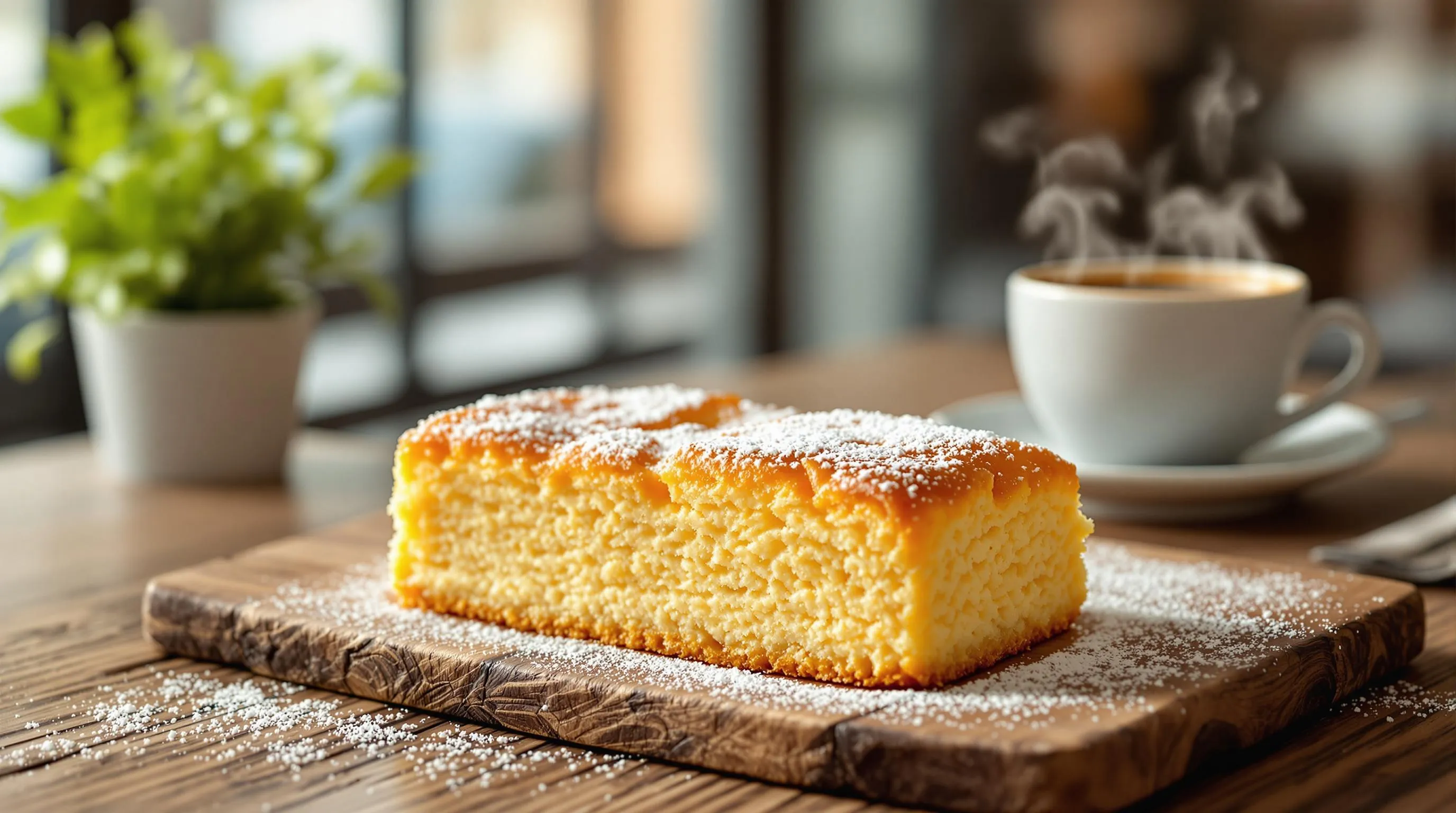
The elegant French financier has a rich history dating back to the 19th century with fascinating ties to the industry of French finance. These delicate almond cakes weren’t always known by their current name, but.
Originally, these delightful treats were called “Visitandines” after a French monastery in the Middle Ages where nuns created a similar almond-based cake. The transformation from religious confection to financial district favorite happened when a clever Parisian pastry chef named Lasne recognized a business opportunity.
Lasne operated his bakery near the bustling Paris stock exchange district, where financiers and bankers formed the majority of his clientele. These busy professionals needed something they could enjoy quickly with their coffee without making a mess or interrupting their workday. The resourceful baker redesigned the oval-shaped Visitandines into small rectangular cakes that resembled gold bars or ingots – a shape that symbolized wealth and prosperity.
This intentional redesign paid homage to his customers’ profession, leading Lasne to rename the cakes “Financiers.” The new name was both a nod to his clientele and a clever marketing strategy that cemented these treats in French culinary history.
The key ingredients remained consistent with the original monastery recipe. The combination of almond flour and beurre noisette (browned butter) gives financiers their distinctive rich yet light almond flavor. This special butter preparation creates a nutty aroma and contributes to the cake’s signature moist interior and crisp exterior.
From their humble beginnings, financiers quickly gained popularity throughout France. Today, they remain a beloved pastry often enjoyed alongside tea or coffee in cafés across the country. In Normandy and other French regions, locals sometimes pair financiers with bolée à cidre – a special cider cup – highlighting their importance in French culinary traditions.
The financier’s journey from monastery kitchen to financial district to worldwide recognition demonstrates how a simple pastry can embody cultural significance. Their golden appearance and rectangular shape continue to reference their namesake – a symbol of prosperity that has stood the test of time in French patisserie.
Conclusion
The golden financier stands as a testament to French patisserie excellence with its perfect balance of nutty brown butter and delicate almond flavor. These elegant treats offer both simplicity in ingredients and sophistication in taste.
You’ll find joy in mastering this versatile recipe that can be adapted for any occasion. Whether served plain with afternoon tea or dressed up with seasonal fruits for a dinner party finale these little golden cakes deliver a moment of luxury in each bite.
With proper technique and quality ingredients your homemade financiers will rival those found in Parisian bakeries. This centuries-old recipe continues to delight with its crisp exterior tender interior and rich buttery goodness making it a timeless addition to your baking repertoire.
